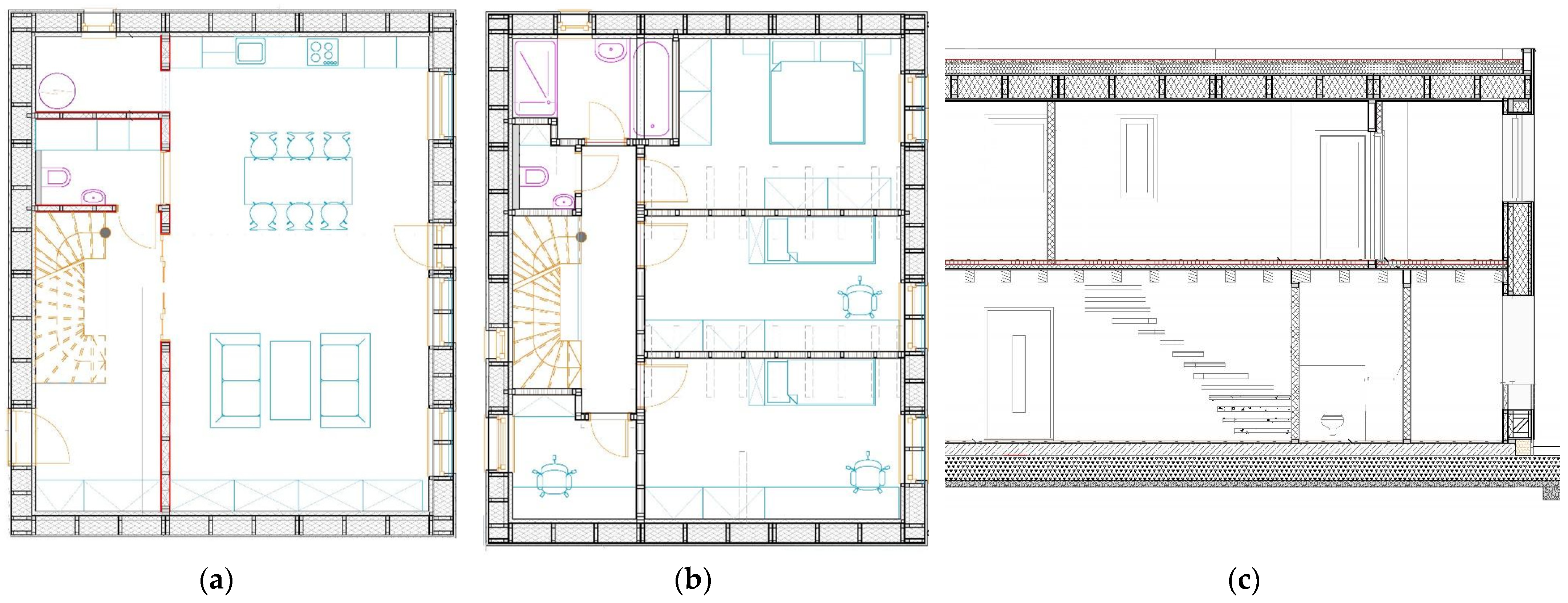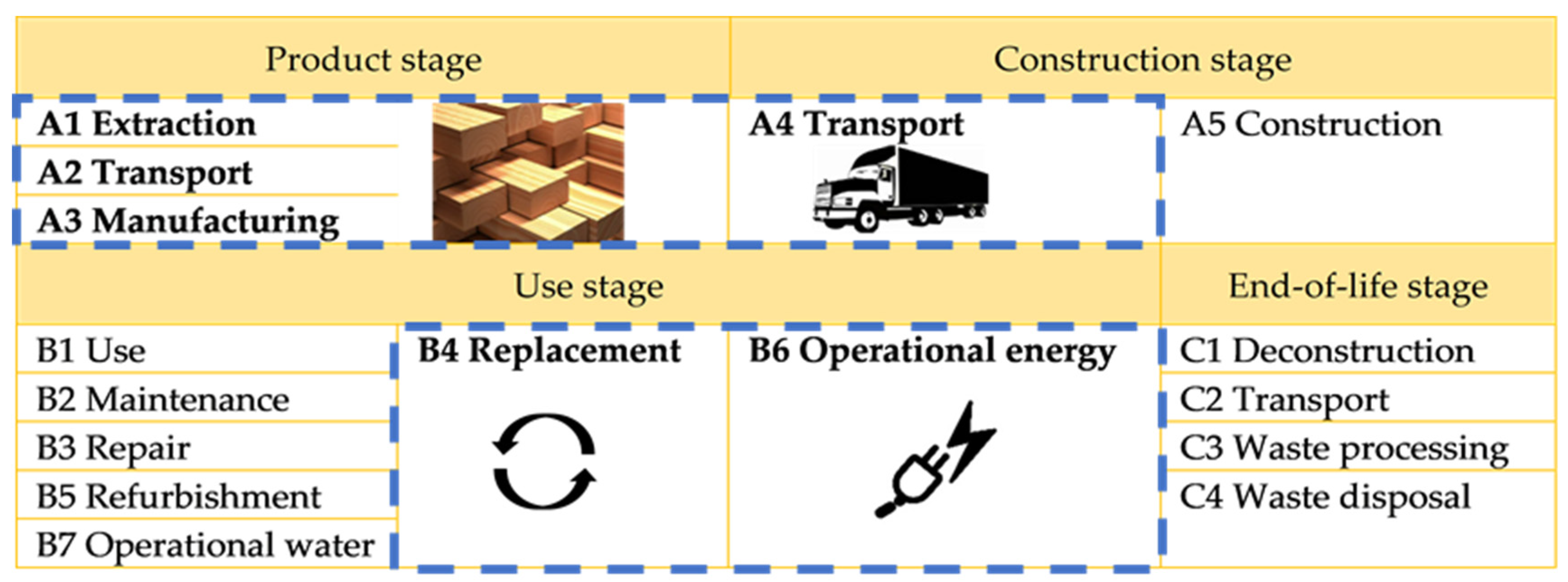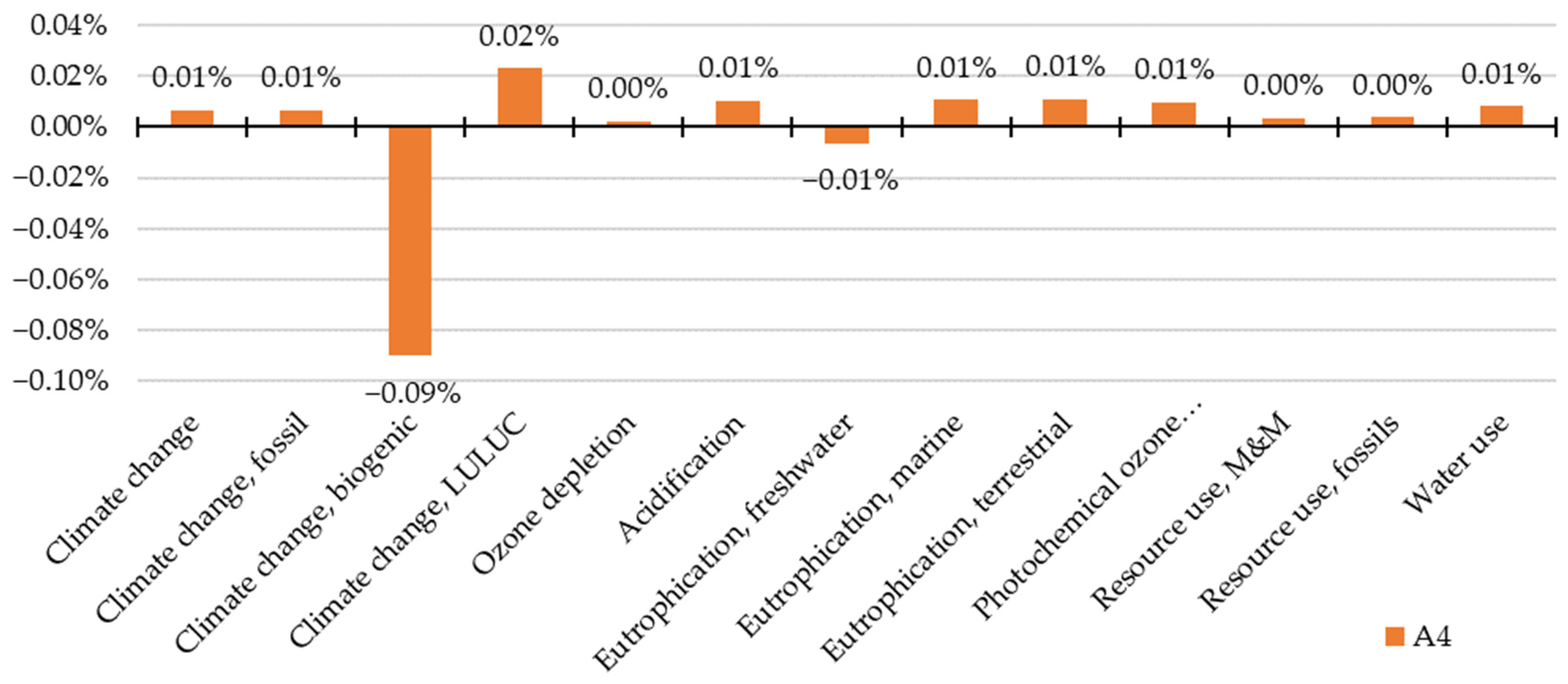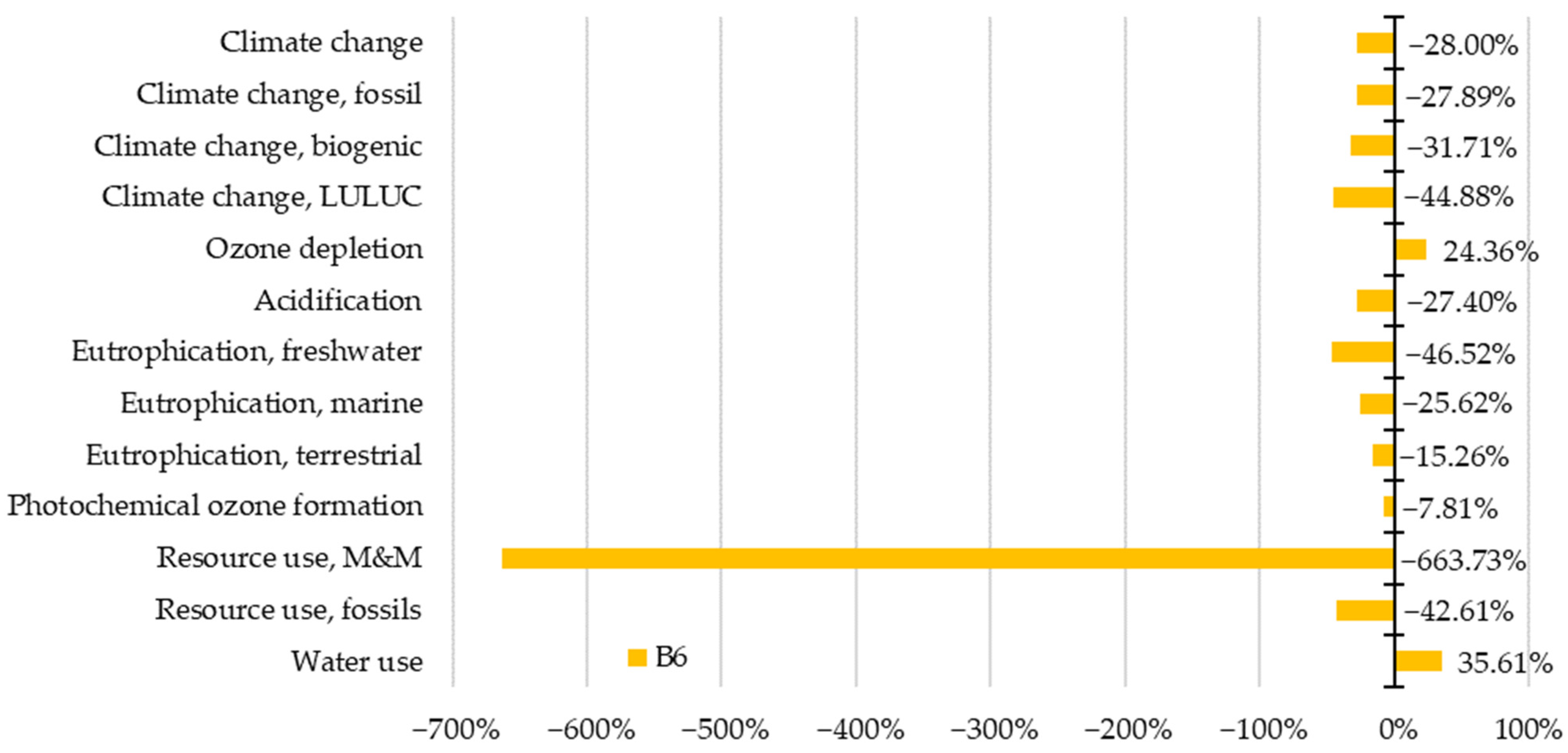Environmental Impacts of Photovoltaic Energy Storage in a Nearly Zero Energy Building Life Cycle
Abstract
1. Introduction
2. Materials and Methods
3. Results
4. Discussion
4.1. Climate Change Impact Categories
4.2. Acidification, Eutrophication and Photochemical Ozone Formation Impact Categories
4.3. Ozone Depletion and Water Use
4.4. Fossil, Minerals and Metals Resource Use Impact Categories
4.5. General Discussion
4.6. Limitations and Strengths
5. Conclusions
- Impact of a vast majority of categories rises in the A1–A3, A4 and B4 stages when battery usage is applied;
- Positive effect of energy storage is observed in the B6 stage, where most of the categories reduce the impact;
- Adding up the impacts through the selected life cycle stages, the storage of photovoltaic energy in most categories reduces the overall impact on the environment, especially in the categories of climate change, fossil climate change, LULUC climate change, acidification, all three eutrophication categories, photochemical ozone creation and use of fossil resources.
- The most significant reduction in impact records freshwater eutrophication (−37.18%), fossils resource use (−30.30%), LULUC climate change (−27.06%) and climate change (−20.53%) categories, respectively.
- On the other hand, impact increase occurs in categories of biogenic climate change, ozone depletion, water use and use of minerals and metals. The last mentioned causes a significant burden of 156.84% impact increment, which can have a significant impact on the availability of these resources in the future and thus affect the economy. Therefore, it is important to take circular economy aspects into account, especially in connection with electrical devices usage.
Author Contributions
Funding
Institutional Review Board Statement
Informed Consent Statement
Data Availability Statement
Conflicts of Interest
References
- Dovie, D.B.K.; Lwasa, S. Correlating negotiation hotspot issues, Paris climate agreement and the international climate policy regime. Environ. Sci. Policy 2017, 77, 1–8. [Google Scholar] [CrossRef]
- Cottrell, C. Avoiding a new era in biopiracy: Including indigenous and local knowledge in nature-based solutions to climate change. Environ. Sci. Policy 2022, 135, 162–168. [Google Scholar] [CrossRef]
- Doyle, L.; Weidlich, I.; Di Maio, E. Developing Insulating Polymeric Foams: Strategies and Research Needs from a Circular Economy Perspective. Materials 2022, 15, 6212. [Google Scholar] [CrossRef]
- Vázquez-Calle, K.; Guillén-Mena, V.; Quesada-Molina, F. Analysis of the Embodied Energy and CO2 Emissions of Ready-Mixed Concrete: A Case Study in Cuenca, Ecuador. Materials 2022, 15, 4896. [Google Scholar] [CrossRef]
- Ryłko-Polak, I.; Komala, W.; Białowiec, A. The Reuse of Biomass and Industrial Waste in Biocomposite Construction Materials for Decreasing Natural Resource Use and Mitigating the Environmental Impact of the Construction Industry: A Review. Materials 2022, 15, 4078. [Google Scholar] [CrossRef] [PubMed]
- European Commission. ‘Fit for 55’: Delivering the EU’s 2030 Climate Target on the Way to Climate Neutrality; European Commission: Brussels, Belgium, 2021. Available online: https://eur-lex.europa.eu/legal-content/EN/TXT/?uri=CELEX%3A52021DC0550 (accessed on 9 September 2022).
- United Nations Environment Programme. 2021 Global Status Report for Buildings and Construction: Towards a Zero-Emission, Efficient and Resilient Buildings and Construction Sector. Nairobi. Available online: https://www.unep.org/resources/report/2021-global-status-report-buildings-and-construction (accessed on 9 September 2022).
- The Paris Agreement. In Proceedings of the Paris UN Climate Change Conference, Paris, France, 12 December 2015.
- Pajek, L.; Potočnik, J.; Košir, M. The effect of a warming climate on the relevance of passive design measures for heating and cooling of European single-family detached buildings. Energy Build. 2022, 261, 111947. [Google Scholar] [CrossRef]
- Maierhofer, D.; Röck, M.; Ruschi Mendes Saade, M.; Hoxha, E.; Passer, A. Critical life cycle assessment of the innovative passive nZEB building concept ‘be 2226′ in view of net-zero carbon targets. Build. Environ. 2022, 223, 109476. [Google Scholar] [CrossRef]
- Decree No. 364/2012 Coll.; Decree of the Ministry of Transport, Construction and Regional Development of the Slovak Republic Implementing Act No. 555/2005 Coll. on the Energy Efficiency of Buildings and on the Amendment of Certain Laws as Amended. Ministry of Transport, Construction and Regional Development of the Slovak Republic: Bratislava, Slovak, 2020.
- European Parliament, Council of the European Union. Directive 2010/31/EU of the European Parliament and of the Council of 19 May 2010 on the Energy Performance of Buildings. Available online: https://eur-lex.europa.eu/legal-content/EN/TXT/PDF/?uri=CELEX:32010L0031&from=EN (accessed on 1 September 2022).
- Acaroğlu, H.; Güllü, M. Climate change caused by renewable and non-renewable energy consumption and economic growth: A time series ARDL analysis for Turkey. Renew. Energy 2022, 193, 434–447. [Google Scholar] [CrossRef]
- Deymi-Dashtebayaz, M.; Nikitin, A.; Davoodi, V.; Nikitina, V.; Hekmatshoar, M.; Shein, V. A new multigenerational solar energy system integrated with near-zero energy building including energy storage–A dynamic energy, exergy, and economic-environmental analyses. Energy Convers. Manag. 2022, 261, 115653. [Google Scholar] [CrossRef]
- Atsu, F.; Adams, S. Energy consumption, finance, and climate change: Does policy uncertainty matter? Econ. Anal. Policy 2021, 70, 490–501. [Google Scholar] [CrossRef]
- Yu, Y.; Radulescu, M.; Ifelunini, A.I.; Ogwu, S.O.; Onwe, J.C.; Jahanger, A. Achieving Carbon Neutrality Pledge through Clean Energy Transition: Linking the Role of Green Innovation and Environmental Policy in E7 Countries. Energies 2022, 15, 6456. [Google Scholar] [CrossRef]
- Sojkova, K.; Volf, M.; Lupisek, A.; Bolliger, R.; Vachal, T. Selection of Favourable Concept of Energy Retrofitting Solution for Social Housing in the Czech Republic Based on Economic Parameters, Greenhouse Gases, and Primary Energy Consumption. Sustainability 2019, 11, 6482. [Google Scholar] [CrossRef]
- Santamouris, M. Innovating to zero the building sector in Europe: Minimising the energy consumption, eradication of the energy poverty and mitigating the local climate change. Sol. Energy 2016, 128, 61–94. [Google Scholar] [CrossRef]
- Muteri, V.; Cellura, M.; Curto, D.; Franzitta, V.; Longo, S.; Mistretta, M.; Parisi, M.L. Review on Life Cycle Assessment of Solar Photovoltaic Panels. Energies 2020, 13, 252. [Google Scholar] [CrossRef]
- EN ISO 14040:2006; Environmental Management. Life Cycle Assessment—Principles and Framework. International Organization for Standardization: Geneva, Switzerland, 2006.
- EN ISO 14044:2006; Environmental Management. Life Cycle Assessment—Requirements and Guidelines. International Organization for Standardization: Geneva, Switzerland, 2006.
- Khang, D.S.; Tan, R.R.; Uy, O.M.; Promentilla, M.A.B.; Tuan, P.D.; Abe, N.; Razon, L.F. Design of experiments for global sensitivity analysis in life cycle assessment: The case of biodiesel in Vietnam. Resour. Conserv. Recycl. 2017, 119, 12–23. [Google Scholar] [CrossRef]
- van Stijn, A.; Malabi Eberhardt, L.C.; Wouterszoon Jansen, B.; Meijer, A. A Circular Economy Life Cycle Assessment (CE-LCA) model for building components. Resour. Conserv. Recycl. 2021, 174, 105683. [Google Scholar] [CrossRef]
- Rønning, A.; Brekke, A. Life cycle assessment (LCA) of the building sector: Strengths and weaknesses. In Eco-Efficient Construction and Building Materials, 1st ed.; Pacheco-Torgal, F., Cabeza, L.F., Labrincha, J., de Magalhães, A., Eds.; Woodhead Publishing: Cambridge, UK, 2014; pp. 63–83. ISBN 9780857097675. [Google Scholar] [CrossRef]
- Lopes Silva, D.A.; Nunes, A.O.; Piekarski, C.M.; da Silva Moris, V.A.; de Souza, L.S.M.; Rodrigues, T.O. Why using different Life Cycle Assessment software tools can generate different results for the same product system? A cause–effect analysis of the problem. Sustain. Prod. Consum. 2019, 20, 304–315. [Google Scholar] [CrossRef]
- Yang, S.; Ma, K.; Liu, Z.; Ren, J.; Man, Y. Development and applicability of life cycle impact assessment methodologies. In Life Cycle Sustainability Assessment for Decision-Making, 1st ed.; Ren, J., Toniolo, S., Eds.; Elsevier: Amsterdam, The Netherlands, 2020; pp. 95–124. ISBN 9780128183557. [Google Scholar] [CrossRef]
- Wernet, G.; Bauer, C.; Steubing, B.; Reinhard, J.; Moreno-Ruiz, E.; Weidema, B. The ecoinvent database version 3 (part I): Overview and methodology. Int. J. LCA 2016, 21, 1218–1230. [Google Scholar] [CrossRef]
- Lamnatou, C.; Chemisana, D.; Cristofari, C. Smart grids and smart technologies in relation to photovoltaics, storage systems, buildings and the environment. Renew. Energy 2022, 185, 1376–1391. [Google Scholar] [CrossRef]
- Vaňová, R.; Igaz, R.; Němec, M.; Štefková, J.; Štefko, J. A PassiveWood-Based Building in Slovakia: Exploring the Life Cycle Impact. Forests 2021, 12, 1613. [Google Scholar] [CrossRef]
- Estokova, A.; Vilcekova, S.; Porhincak, M. Analyzing Embodied Energy, Global Warming and Acidification Potentials of Materials in Residential Buildings. Procedia. Eng. 2017, 180, 1675–1683. [Google Scholar] [CrossRef]
- Mitterpach, J.; Vaňová, R.; Šedivka, P.; Štefko, J. A Comparison of the Environmental Performance between Construction Materials and Operational Energy of Nearly Zero-Energy Wood-Based Educational Building. Forests 2022, 13, 220. [Google Scholar] [CrossRef]
- Zhao, G.; Searle, J.; Clarke, J.; Roberts, M.; Allen, S.; Baker, J. Environmental Analysis of Integrating Photovoltaics and Energy Storage in Building. Procedia CIRP 2022, 105, 613–618. [Google Scholar] [CrossRef]
- PRé Consultants. Introduction to LCA with SimaPro; PRé Consultants: Amersfoort, The Netherlands, 2016; 80p, Available online: https://pre-sustainability.com/legacy/download/SimaPro8IntroductionToLCA.pdf (accessed on 1 September 2022).
- EPD International AB. Product Category Rules: Buildings; EPD International AB: Stockholm, Sweden, 2018; 45p, Available online: https://api.environdec.com/api/v1/EPDLibrary/Files/ce762c07-77ef-4b40-9c42-406ec5a02bab/Data (accessed on 1 September 2022).
- Li, X.; Ou, X.; Zhang, X.; Zhang, Q.; Zhang, X. Life-cycle fossil energy consumption and greenhouse gas emission intensity of dominant secondary energy pathways of China in 2010. Energy 2013, 50, 15–23. [Google Scholar] [CrossRef]
- European Commission. Share of Renewable Energy in Gross Final Energy Consumption by Sector. Available online: https://ec.europa.eu/eurostat/web/products-datasets/-/sdg_07_40 (accessed on 12 September 2022).
- Herrando, M.; Elduque, D.; Javierre, C.; Fueyo, N. Life Cycle Assessment of solar energy systems for the provision of heating, cooling and electricity in buildings: A comparative analysis. Energy Convers. Manag. 2022, 257, 115402. [Google Scholar] [CrossRef]
- Gandiglio, M.; Marocco, P.; Bianco, I.; Lovera, D.; Blengini, G.A.; Santarelli, M. Life cycle assessment of a renewable energy system with hydrogen-battery storage for a remote off-grid community. Int. J. Hydrog. Energy 2022, 47, 32822–32834. [Google Scholar] [CrossRef]
- Jasper, F.B.; Späthe, J.; Baumann, M.; Peters, J.F.; Ruhland, J.; Weil, M. Life cycle assessment (LCA) of a battery home storage system based on primary data. J. Clean. Prod. 2022, 366, 132899. [Google Scholar] [CrossRef]
- Souliotis, M.; Arnaoutakis, N.; Panaras, G.; Kavga, A.; Papaefthimiou, S. Experimental study and Life Cycle Assessment (LCA) of Hybrid Photovoltaic/Thermal (PV/T) solar systems for domestic applications. Renew. Energy 2018, 126, 708–723. [Google Scholar] [CrossRef]
- Raugei, M.; Winfield, P. Prospective LCA of the production and EoL recycling of a novel type of Li-ion battery for electric vehicles. J. Clean. Prod. 2019, 213, 926–932. [Google Scholar] [CrossRef]
- Pradel, M.; Garcia, J.; Vaija, M.S. A framework for good practices to assess abiotic mineral resource depletion in Life Cycle Assessment. J. Clean. Prod. 2021, 279, 123296. [Google Scholar] [CrossRef]
- Abdelbaky, M.; Peeters, J.R.; den Eynde, S.V.; Zaplana, I.; Dewulf, W. A comparative assessment of resource-use criticality in advanced lithium-ion battery technologies. Procedia CIRP 2022, 105, 7–12. [Google Scholar] [CrossRef]
- Franco, M.A.J.Q.; Pawar, P.; Wu, X. Green building policies in cities: A comparative assessment and analysis. Energy Build. 2021, 231, 110561. [Google Scholar] [CrossRef]
- D’Agostino, D.; Tzeiranaki, S.T.; Zangheri, P.; Bertoldi, P. Assessing Nearly Zero Energy Buildings (NZEBs) development in Europe. Energy Strategy Rev. 2021, 36, 100680. [Google Scholar] [CrossRef]
- Wu, T.; Gong, M.; Xiao, J. Preliminary sensitivity study on an life cycle assessment (LCA) tool via assessing a hybrid timber building. J. Bioresour. Bioprod. 2020, 5, 108–113. [Google Scholar] [CrossRef]
- Arshad, F.; Lin, J.; Manurkar, N.; Fan, E.; Ahmad, A.; Tariq, M.; Wu, F.; Chen, R.; Li, L. Life Cycle Assessment of Lithium-ion Batteries: A Critical Review. Resour. Conserv. Recycl. 2022, 180, 106164. [Google Scholar] [CrossRef]
- De Masi, R.F.; Gigante, A.; Vanoli, G.P. Are nZEB design solutions environmental sustainable? Sensitive analysis for building envelope configurations and photovoltaic integration in different climates. J. Build. Eng. 2021, 39, 102292. [Google Scholar] [CrossRef]
- Kylili, A.; Ilic, M.; Fokaides, P.A. Whole-building Life Cycle Assessment (LCA) of a passive house of the sub-tropical climatic zone. Resour. Conserv. Recycl. 2017, 116, 169–177. [Google Scholar] [CrossRef]
- Morsi, D.M.A.; Ismaeel, W.S.E.; Ehab, A.; Othman, A.A.E. BIM-based life cycle assessment for different structural system scenarios of a residential building. Ain Shams Eng. J. 2022, 13, 101802. [Google Scholar] [CrossRef]






| Material | Amount | Distance Travelled (km) |
|---|---|---|
| Timber | 17,648.04 kg * | 400 |
| Oriented strand board | 9881.80 kg * | 100 |
| High density fiberboard | 3083.12 kg * | 100 |
| Gypsum plasterboard | 8439.42 kg * | 100 |
| Rock wool | 2245.89 kg * | 100 |
| Brick | 6336 kg * | 100 |
| Reinforcing steel | 1500 kg | 200 |
| Steel connectors | 2331 kg | 40 |
| Gravel | 23,720 kg | 80 |
| Concrete | 45,210 kg | 240 |
| Foam glass | 12,062.4 kg | 200 |
| Extensive vegetation | 9074.8 kg | 200 |
| Triple-glazing wood-frame windows | 4.42 m2 +18.84 m2 | 200 ** |
| Inner doors | 16.2 m2 | 200 ** |
| Outer doors | 2.88 m2 | 200 ** |
| Mineral cover plaster | 2934.5 kg * | 40 |
| Reccuperation system | 200 kg | 100 |
| Refrigerants | 57.4 kg | 100 |
| Scaffolding and accessories | 162.7 + 40 kg | 200 ** |
| Packaging material | 469.6 kg | - |
| Stage | Input | Amount |
|---|---|---|
| B4 | Filters in the recuperation system | 100 pcs |
| Heat exchanger | 2.5 pcs | |
| Heat pump | 2.5 pcs | |
| Photovoltaic panel | 240 kg | |
| Refrigerant R134a | 0.73 kg | |
| Propylene glycol | 178.75 kg | |
| B6 | Electricity (Slovak electricity grid) | 207.09 MWh |
| Heat | 290.33 MWh | |
| Photovoltaic electricity | 197.8 MWh |
| Impact Category | Unit | Life Cycle Stage | Total | |||
|---|---|---|---|---|---|---|
| A1–A3 | A4 | B4 | B6 | |||
| Climate change | kg CO2 eq | 6840.48 | 5099.21 | 20,264.71 | 119,336.79 | 151,541.2 |
| Climate change, fossil | kg CO2 eq | 55,559.55 | 5092.4 | 20,164.11 | 116,969.08 | 197,785.14 |
| Climate change, biogenic | kg CO2 eq | −49,034.4 | 4.44 | 64.04 | 1955.42 | −47,010.5 |
| Climate change, LULUC * | kg CO2 eq | 200.16 | 2.12 | 28 | 373.97 | 604.25 |
| Ozone depletion | g CFC-11 eq | 4.64 | 1.17 | 8.46 | 6.51 | 20.79 |
| Acidification | mol H+ eq | 338.1 | 20.57 | 154.08 | 735.8 | 1248.54 |
| Eutrophication, freshwater | kg P eq | 18.1 | 0.35 | 11.59 | 158.57 | 188.6 |
| Eutrophication, marine | kg N eq | 75.65 | 6.13 | 20.06 | 113.46 | 215.31 |
| Eutrophication, terrestrial | mol N eq | 875.58 | 66.98 | 238.03 | 879.52 | 2060.1 |
| Photochemical ozone formation | kg NMVOC eq | 250.89 | 20.55 | 67.78 | 238.59 | 577.81 |
| Resource use, M&M | kg Sb eq | 0.73 | 0.02 | 1.98 | −0.41 | 2.33 |
| Resource use, fossils | MJ | 743,545.97 | 76,802.34 | 215,316.74 | 2,793,198.1 | 3,828,863.15 |
| Water use | m3 depriv. | 15,656.37 | 237.78 | 11,115.7 | 21,385.71 | 48,395.57 |
| Value | A1–A3 | A4 | B4 | B6 | Total |
|---|---|---|---|---|---|
| mean | 2.81% | 0.00% | 17.78% | −69.34% | 1.95% |
| max | 20.53% | 0.02% | 38.23% | 35.61% | 156.84% |
| absolute max | 20.53% | 0.09% | 38.23% | 663.73% | 156.84% |
| min | 0.00% | −0.09% | 1.80% | −663.73% | −37.18% |
| absolute min | 0.00% | 0.00% | 1.80% | 7.81% | 0.92% |
| median | 0.80% | 0.01% | 15.61% | −27.89% | −11.65% |
| Climate Change Impact Ratio of A1–A3 and B6 | Share of A1–A3 Impact (%) | Source |
|---|---|---|
| 1:18 | 5.55 | Reference life cycle |
| 2:23 | 8.70 | Alternative life cycle |
| 12:21 | 57.14 | Maierhofer et al. [10] |
Publisher’s Note: MDPI stays neutral with regard to jurisdictional claims in published maps and institutional affiliations. |
© 2022 by the authors. Licensee MDPI, Basel, Switzerland. This article is an open access article distributed under the terms and conditions of the Creative Commons Attribution (CC BY) license (https://creativecommons.org/licenses/by/4.0/).
Share and Cite
Vanova, R.; Nemec, M. Environmental Impacts of Photovoltaic Energy Storage in a Nearly Zero Energy Building Life Cycle. Materials 2022, 15, 7328. https://doi.org/10.3390/ma15207328
Vanova R, Nemec M. Environmental Impacts of Photovoltaic Energy Storage in a Nearly Zero Energy Building Life Cycle. Materials. 2022; 15(20):7328. https://doi.org/10.3390/ma15207328
Chicago/Turabian StyleVanova, Rozalia, and Miroslav Nemec. 2022. "Environmental Impacts of Photovoltaic Energy Storage in a Nearly Zero Energy Building Life Cycle" Materials 15, no. 20: 7328. https://doi.org/10.3390/ma15207328
APA StyleVanova, R., & Nemec, M. (2022). Environmental Impacts of Photovoltaic Energy Storage in a Nearly Zero Energy Building Life Cycle. Materials, 15(20), 7328. https://doi.org/10.3390/ma15207328







